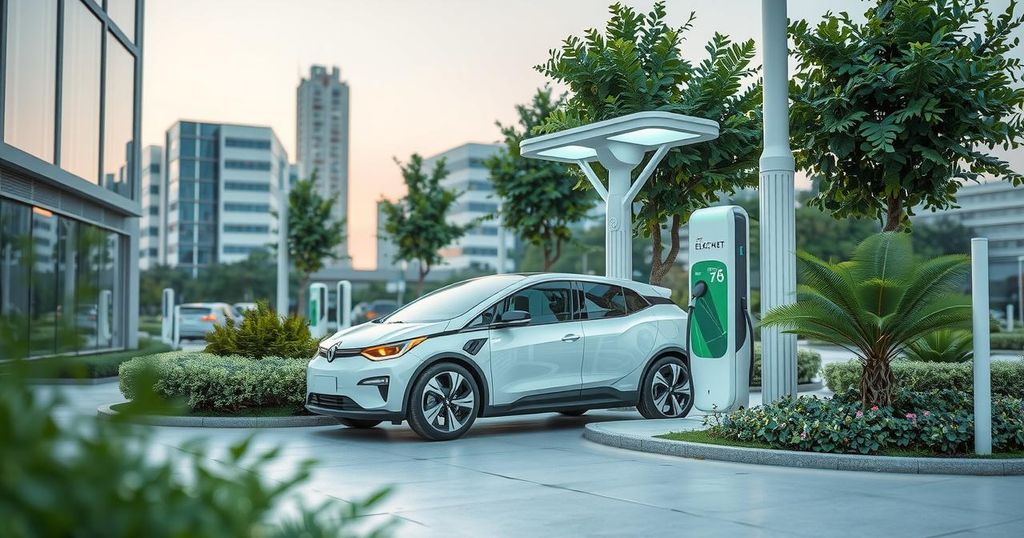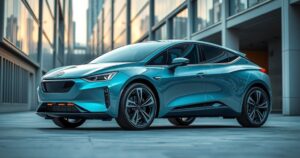Powering Pakistan’s EV Revolution: Challenges and Opportunities

Pakistan’s shift to electric vehicles (EVs) is crucial for lowering emissions and ensuring sustainability, especially with a rapidly urbanizing population. The government aims for 30% EV adoption by 2030, potentially saving $800 million annually and reducing emissions by moving public transport to EVs. Key challenges include high costs, limited infrastructure, and financing barriers. Learning from successful examples in other countries can guide Pakistan’s transition towards a robust electric mobility ecosystem.
Pakistan’s shift towards electric vehicles (EVs) is essential for reducing greenhouse gas emissions and enhancing sustainability. With a population projected to exceed 400 million and significant urban growth over the next 25 years, transitioning from internal combustion engine (ICE) vehicles to EVs will be vital for addressing environmental and socio-economic challenges.
EV adoption supports economic and environmental goals, aligning with global decarbonization efforts. Pakistan aims for 30% EV penetration by 2030, potentially saving over $800 million annually while substantially decreasing emissions by moving public transport from ICE vehicles to EVs.
A comprehensive strategy is needed to tackle financial, regulatory, and infrastructure obstacles. The New Energy Vehicles Policy (2025-2030) is under development and emphasizes collaboration among stakeholders like policymakers, banks, and industry experts, highlighted in a recent forum hosted by the Sustainable Development Policy Institute (SDPI).
High upfront costs remain a major barrier to EV adoption, with batteries accounting for 40-50% of total EV costs. Although lithium prices fell 60% in 2023, affordability is still a concern. Additionally, the sparse charging infrastructure in Pakistan must be addressed, potentially through public-private partnerships.
Concerns surrounding limited battery warranties and resale value uncertainty also hinder consumer confidence. Establishing a secondary market for EVs and enhancing the national grid are critical to supporting EV integration. Upgrading the grid by the National Transmission and Despatch Company is urgent to facilitate this transition.
The inconsistent electricity supply compounds range anxiety for potential EV users, necessitating renewable energy integration at charging stations. High interest rates create financing challenges, requiring substantial subsidies to ease the shift from ICE vehicles. Concessional financing from development banks is essential to support EV infrastructure in partnership with the private sector.
Lessons can be learned from initiatives in developing countries. Kenya has introduced electric motorcycles with affordable financing for rural mobility. Vietnam’s public-private partnerships have been pivotal in EV infrastructure expansion, demonstrating scalable solutions that Pakistan can adapt to meet its specific needs.
China’s experience offers valuable insight, having invested $230 billion from 2009 to 2023 in rebates, tax exemptions, and infrastructure improvements, promoting rapid EV adoption. Pakistan can adopt a similar phased approach to incentivize private sector participation and localize EV production through partnerships with Chinese manufacturers like BYD and Geely Farizon.
India’s EV adoption strategy provides another relevant model. Government incentives, along with the National Electric Mobility Mission Plan 2020, aim for 30% EVs in new road mobility by 2030. Initiatives such as FAME foster collaboration among banks and the government to fund EV adoption.
The Indian Energy Efficiency Services Limited (EESL) serves as a successful public-private partnership in installing public charging infrastructure, showcasing the model’s effectiveness. Targeted financing solutions from Indian banks are enhancing EV ownership affordability, including schemes with lower interest rates and longer repayment terms.
The Reserve Bank of India encourages EV financing and has initiated credit guarantee schemes for clean energy startups. Furthermore, green bonds have begun to mobilize capital for clean energy projects, providing low-cost financing for EV manufacturing and infrastructure in India, a strategy Pakistan might consider.
For collaboration to thrive in Pakistan’s EV ecosystem, a consultative approach among stakeholders is vital. Offering incentives tied to minimum local content requirements can enhance participation and growth within the sector. However, effective regulatory measures must accompany such incentives to guide development responsibly.
Creating a climate-friendly mobility system in Pakistan aligns with several United Nations Sustainable Development Goals (SDGs), particularly in clean energy, industry innovation, sustainable cities, and climate action. Fostering local EV manufacturing and associated industries promotes decent work and economic growth while potentially qualifying for international carbon credits.
Transitioning to a sustainable mobility ecosystem poses challenges and opportunities for Pakistan. By addressing financial barriers, adopting lessons from regional success stories, and implementing effective policies, Pakistan can pave the way for a sustainable future. Through strategic public-private coordination and targeted financing, the country can achieve its environmental goals while accelerating economic development.
The urgency for Pakistan to transition to electric vehicles (EVs) is driven by the need to reduce greenhouse gas emissions in light of increasing urbanization and population growth. Striving for sustainability, Pakistan’s government aims for 30% EV market penetration by 2030, recognizing the potential economic savings and environmental benefits associated with this shift. Addressing critical challenges such as high costs, insufficient infrastructure, and financing barriers is essential to realize this transition successfully. By learning from the experiences of other countries and fostering collaboration among stakeholders, Pakistan can effectively build an EV ecosystem that contributes to global decarbonization efforts.
The path towards an electric vehicle revolution in Pakistan is fraught with challenges but also rich in opportunities. By strategically addressing financing, infrastructure, and regulatory issues, while learning from international best practices, Pakistan can establish a sustainable and economically viable EV landscape. Collaborative efforts among government, private sector, and development entities will be vital for fostering innovation and achieving long-term environmental goals, ultimately supporting economic sustainability and growth in the region.
Original Source: www.thenews.com.pk




